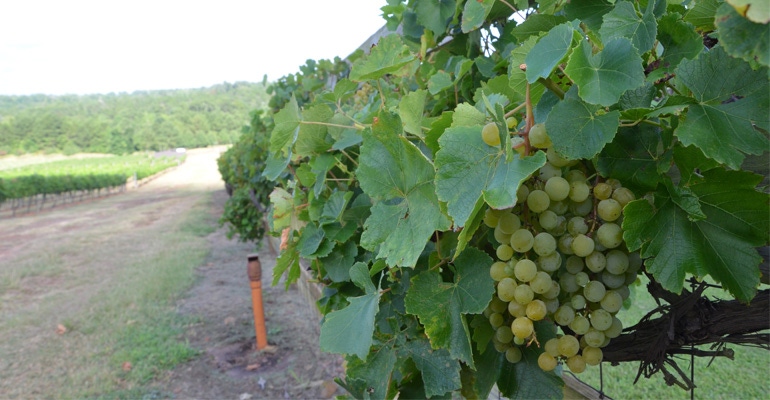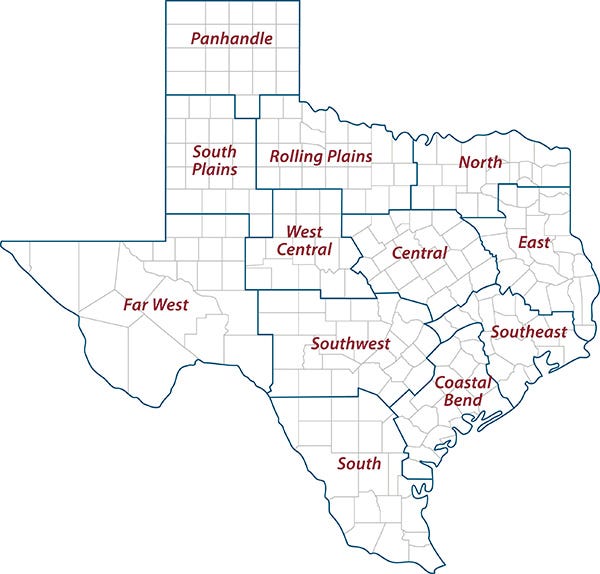
Wine grape growers around the state experienced challenging conditions, but the 2018 season was expected to produce high-quality fruit, according to Texas A&M AgriLife Extension Service experts.
Michael Cook, AgriLife Extension viticulture program specialist, Denton, said harvests are far from complete but the 2018 growing season threw wine grape growers several curveballs that likely led to a 10 percent reduction in yields overall.
Good spring moisture levels started the season off well, and the normal winter temperatures helped abate insect pressure into March and April compared to last year, he said. But then Mother Nature kept growers on their toes the rest of the season.
Growers in the northern parts of the state experienced spring frost incidents that caused damaging losses, he said. Late frosts were followed by extreme heat and drought.
“Grapevines awakened as predicted this year and everything looked great, but frost events along the Red River down to Stephenville damaged around 10-20 percent of the crop in those areas,” he said. “Then Mother Nature turned the heat up, and it’s been challenging due to hot, dry and windy conditions since.”
Cook said temperatures reached 100-plus degrees around June 1 and have not let up.
“In North and Northeast Texas, we’ve dealt with a fair amount of drought and high temperatures,” he said. “Central and North Central Texas temperatures have reached 116 degrees and remained above 100 degrees for three to four weeks depending on location, which has elevated vine stress and kept growers on their toes.”
Cook said overall yields will be lower than 2017, which was a bumper year, but that grape quality is expected to be very high.
“Grapes are smaller, but they are packed with sugar and flavor,” he said. “The season was a struggle for many, but growers are excited about the potential quality of their grapes.”
Dr. Pierre Helwi, AgriLife Extension viticulture specialist, Lubbock, said smaller grapes typically mean better quality, but there is still concern about rapid-ripening in grapes destined for red wines.
“Ripening will be very fast because of the high temperatures,” he said. “Grapes have shown good sugar and acidity levels, but phenolic maturity may be quicker than normal, which could negatively affect quality.”
Helwi said there were few disease and pest issues in the Panhandle and Southern Plains because conditions have been extremely dry. Growers have relied on irrigation to maintain their vines.
Brianna Hoge, AgriLife Extension viticulture specialist, Fredericksburg, said constant irrigation has lowered sugar brix counts in Central Texas grapes. Producers are reporting sugar counts lower than the optimal 21-22 brix for white grapes and 23 or more brix for reds.
“They’re doing what they can to manage sugar counts, but we’re advising growers they shouldn’t stress the vines further to get their grapes’ sugars up,” she said. “Overall, quality looks good. Exposure to intense sun caused some sunburn to white varieties, but the biggest impact was how drought affected yields as it did in other parts of the state.”
Hoge said some Central Texas growers noted they were expecting 4 tons of grapes per acre but harvested 1 ton per acre. Harvests in Central Texas were also earlier than typical due to rapid ripening.
Cook said AgriLife Extension specialists are focusing now on helping wine grape growers maintain the health of their vines to prevent problems associated with stresses this season to resonate into the 2019 growing season.
Hoge said specialists are also advising thorough cleaning of vineyards to remove possible diseased debris that could become a problem next season. They are also stressing that if the drought continues, growers should be mindful to provide necessary amounts of water throughout dormancy.
“We’re helping growers keep their vines healthy going into winter and next season,” he said. “Vine health prior to dormancy will be a big factor in next year’s production, and so we want to help them recover as much as possible.”
AgriLife Extension district reporters compiled the following summaries:

The 12 Texas A&M AgriLife Extension Districts
The 12 Texas A&M AgriLife Extension Districts
CENTRAL: Drought conditions continued with high temperatures. Very few pastures have any available grazing left, and most stock tanks were very low or dry. Producers were cutting cattle herds. Prices were holding on, but sheep and goat prices dropped a bit. Corn and milo stalks were baled for livestock feed. Fire hazard conditions continued. Livestock were being supplemented. Dryland cotton looked good two weeks ago but was showing heat and drought stress. To this point in the growing season, all dryland crops were 100 percent losses. Most counties reported poor soil moisture and overall rangeland and pasture conditions. Most crop and livestock conditions were fair overall.
ROLLING PLAINS: Hot, dry weather prevailed, though temperatures moderated from the 110-plus degree range experienced in previous weeks. A few southern counties reported receiving 0.5-1.1 inches of spotty rain. Pastures and rangeland were in poor condition. With no moisture, grasses turned dormant and ranchers were forced to increase supplemental feed. Lack of hay for baling and for sale were becoming serious issues. An increased number of cattle were being shipped to market. Irrigated cotton was fair to good, but dryland fields had a very hard start and conditions haven’t improved. Plants were beginning to show signs of lack of moisture, and boll counts were very slim. Native trees were showing signs of drought stress. Forecasts were calling for cooler temperatures and rain.
COASTAL BEND: Hot and dry conditions continued, with some scattered showers reported in a few areas. Corn and sorghum harvests continued, and rice harvest began. Below-average yields were reported so far. Cotton in the southern end of the district was being harvested. Cotton fields in other areas looked good, and bolls were starting to open up with some defoliation applications being made. The pecan crop looked good, but orchards needed some heavy rainfall as trees entered kernel development. Pasture conditions were beginning to deteriorate, and supplemental feeding began in some areas. Hay baling was in full swing with an average crop. Livestock remained in fair condition, although flies have become a nuisance.
EAST: Drought conditions and growing fire danger continued despite scattered showers throughout the district. Panola County reported one small area of the county received 6 inches of rain in a half hour, but the majority of areas only received 0.25-1 inch of rainfall. Cherokee County producers were forced to move livestock due to ponds and creeks going dry. Marion and Harrison county producers were concerned about declining stock and pond water. Lack of hay continued across the district causing Gregg and Marion county producers to feed hay. Sabine County reported continued high production levels of forage and hay. Pasture and rangeland conditions were good in Sabine County, fair in San Augustine, Gregg and Shelby counties and all other counties reported poor to very poor conditions. Some Marion County producers started preparations for fall gardens. Subsoil conditions were reported to be adequate in Sabine, Jasper, San Augustine and Gregg counties, while all other counties reported short to very short conditions. Topsoil conditions were adequate in Sabine, Jasper and San Augustine counties, and all other counties reported short to very short conditions. Producers began culling cattle in Cherokee and Gregg counties. Cattle market numbers in Houston and Shelby counties remained steady, and calf prices were up per hundredweight in Houston County. Armyworm infestations were devastating forages in Cherokee and Sabine counties. Wild pigs continued to cause difficulties in Shelby County.
SOUTH PLAINS: Subsoil and topsoil moisture levels remained adequate to short. Lack of rain, high temperatures and wind continued to dry out already parched land. Producers continued to supplement with irrigation. Sorghum, cotton, peanuts and corn continued to mature. Producers were conducting weed and pest management. Some cotton was plowed up after insurance adjustments. Pastures and rangeland needed moisture. Many cattle producers were shipping herds due to drought conditions and declining tank water. Cattle were in good condition.
PANHANDLE: Conditions were warm and windy with average temperatures. Some moisture was received. A good, general soaking rain was needed throughout the district. Soil moisture levels continued to be short to very short. Armstrong County received some rain but was still experiencing wildfires. Hall County drought conditions continued with spotty rains in some areas. Rangeland and pastures were still in very good condition in some areas, and cattle were performing well. Cattle body conditions and pastures continued to decline in other areas. Irrigated crops looked good. Moore County received scattered showers but little accumulation. Ochiltree County wheat pre-plant activity continued. Some late-season irrigation was provided for corn and cotton. Many cotton fields were nearing cut out. Insect scouting and control continued in all crops.
NORTH: A cold front brought cooler temperatures but very little rain. Daytime temperatures fell to the upper 90s, and nighttime temperatures ranged in the mid- to upper-60s. The cooler weather helped, but more rain was needed. Crops, pastures and hay fields were showing signs of stress, and stock ponds were receding. Topsoil and subsoil moisture levels were mostly short, with some counties reporting very short. Corn was 40-45 percent harvested. Cotton and soybean fields were showing stress. Soybeans and corn stalks were being harvested for forage. Cattle looked good considering the tough conditions and low-quality forage they were eating. Hay production was about 30 percent of normal. Pastures looked green but, were not growing. Some ranchers were considering early weaning and/or culling lower producing or open cows.
FAR WEST: Temperatures were in the upper 90s to 100 degrees with lows in the 60s. Scattered showers averaged 0.2-2-plus inches of rainfall. Drought was negatively impacting farm and ranch operations. Producers continued to irrigate crops. Producers harvested some haygrazer. Pecan trees were showing drop due to lack of water and pecan nut casebearer. Producers noted grey ash lady beetles and limited aphids. Dry weather with wind was causing fire danger concern. Calves, sheep and goats were shipped to market.
WEST CENTRAL: Hot and dry weather continued. There was virtually no forage production as grasses of all kinds shut down due to heat and lack of moisture. Cotton remained in poor condition due to moisture stress, and many acres failed. Very little hay was available to buy, and available bales were selling for $100-$125 per round bale. Stock tanks were dry or at critical levels making water availability a serious issue for many producers. Livestock producers continued to cull herds as supplemental feeding of livestock increased.
SOUTHEAST: Pastures were very dry. Most hay producers were waiting on more rain. Rice harvest was moving along very well. Corn and sorghum harvests started. Pastures were dry, but livestock appeared to be in good health. Rangeland and pasture ratings varied from fair to very poor, with fair ratings being most common. Soil-moisture levels ranged from adequate to short with short being most common.
SOUTHWEST: Moisture conditions continued to decline. Rangeland and pasture conditions continued to decline as well. Below average crop yields were being reported. Some ranchers started feeding hay and were selling livestock.
SOUTH: Weather continued to be hot and dry, and soil moisture levels were short to very short. Temperatures were above 100 degrees most days in most areas. Scattered rain showers were reported in Jim Wells County. Peanut fields continued to be irrigated. Corn and sorghum harvests were complete in most areas. Cotton harvest started on some early planted dryland fields. The rest of the cotton crop was in the open-boll stage. Pasture and rangeland conditions were poor, and livestock supplemental feeding continued. Local livestock markets were steady, offering slightly above-average volumes in all classes of beef cattle with fair to good body conditions on most livestock. High temperatures were stressing surface water sources as evaporation rates continued to rise. Body condition scores on cattle remained fair. Hay harvest was slowing due to scorching heat. Pecan growers continued to apply water to orchards.
About the Author(s)
You May Also Like




